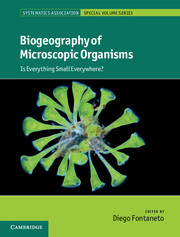Book contents
-
Frontmatter
-
Contents
-
List of contributors
-
Preface
- Part I
Theoretical framework
- 1
Why biogeography of microorganisms?
- 2
Historical biogeography, microbial endemism and the role of classification: everything is endemic
- Part II
Prokaryotes
- Part III
Unicellular eukaryotes
- Part IV
Pluricellular eukaryotes
- Part V
Processes
-
Index
-
Systematics Association Publications
-
Systematics Association Special Volumes
-
Plate section
- References
2 - Historical biogeography, microbial endemism and the role of classification: everything is endemic
from Part I - Theoretical framework
Published online by Cambridge University Press: 05 August 2012
- Frontmatter
- Contents
- List of contributors
- Preface
- Part I Theoretical framework
- 1 Why biogeography of microorganisms?
- 2 Historical biogeography, microbial endemism and the role of classification: everything is endemic
- Part II Prokaryotes
- Part III Unicellular eukaryotes
- Part IV Pluricellular eukaryotes
- Part V Processes
- Index
- Systematics Association Publications
- Systematics Association Special Volumes
- Plate section
- References
Summary
Introduction
Microbial biogeography, the study of the distribution of ‘small’ organisms, has been said to have gained renewed vigour because of the recently resurrected ‘Everything is everywhere’ hypothesis (EiE) (Finlay, 2002; Fenchel and Finlay 2003; Finlay and Esteban, 2007). That hypothesis was concisely summarised by the organisers of the conference on the biogeography of microorganisms in Leiden, August 2009, in the promotional material:
This symposium is based around the hypothesis of everything-is-everywhere (EiE) amongst small organisms. This hypothesis was proposed at the beginning of the twentieth century for microbial diversity and, about ten years ago, extended to describe spatial patterns of diversity for any organism smaller than two mm, under the simple observation that microscopic organisms such as protists seem to be cosmopolitan, at least in habitats that support their growth. Since its recent resurgence, this topic became hotly debated, with evidence apparently supporting and denying the hypothesis.
The slogan ‘Everything is everywhere, [but] the environment selects’ has been attributed to the microbiologist Lourens G.M. Baas Becking (Baas Becking, 1934). The word ‘but’ is in brackets as sometimes the phrase appears as ‘Everything is everywhere, the environment selects’ (e.g. Wilkinson, 2001), at other times as ‘Everything is everywhere, and the environment selects’ (e.g. Kuehne et al., 2007, my italics).
- Type
- Chapter
- Information
-
Biogeography of Microscopic OrganismsIs Everything Small Everywhere?, pp. 11 - 32Publisher: Cambridge University PressPrint publication year: 2011
References
- 14
- Cited by



